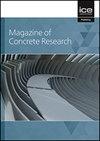矿渣对富氯化物地聚合物混凝土强度、微观结构和钢筋腐蚀的影响
IF 1.6
4区 工程技术
Q3 CONSTRUCTION & BUILDING TECHNOLOGY
引用次数: 0
摘要
本研究调查了矿渣替代率(0%、30%和60%)和氯化物浓度(1.5%和3.5%NaCl)对28至360天强度发展过程中微观结构变化、600天钢筋腐蚀以及富含氯化物的地质聚合物混凝土(GC)中氯化物结合行为的影响。通过场发射扫描电子显微镜(FESEM)、能量分散X射线光谱(EDS)、X射线衍射(XRD)和傅里叶变换红外光谱(FTIR)分析评估了GC的微观结构变化。研究结果表明,粉煤灰-气相色谱(F-GC)混合料的强度增强程度较高。GC混合物中氯化物的存在导致所有龄期的强度降低,然而,用较高矿渣制成的飞灰/矿渣GC(F/S-GC)混合物的强度降低大多低于其他混合物。此外,与其他混合物相比,用较高矿渣制成的F/S-GC混合物表现出较小的负腐蚀电位(Ecor)和较低的腐蚀电流密度(Icor),表明其具有更好的抗钢筋腐蚀性。对于矿渣含量较高的GC混合物,氯化物结合能力大多较高。与F-GC混合物相比,F/S-GC混合物中含钙凝胶的量越大,Ca/Si原子比越高,有助于减少氯化物对强度降低和钢筋腐蚀的影响。Si-O-Si(Al)键向较低波数的移动表明形成了更多的结合凝胶,从而在F/S-GC混合物中形成了更致密的微观结构。本文章由计算机程序翻译,如有差异,请以英文原文为准。
Role of slag in strength, microstructure, and rebar corrosion in chloride-rich geopolymer concrete
This study investigates the role of slag substitution (0%, 30%, and 60%), and chloride concentration (1.5% and 3.5% NaCl) on microstructural changes during strength development between 28 and 360 days, rebar corrosion up to 600 days, and chloride binding behaviour in chloride-rich geopolymer concrete (GC). The microstructural changes of GC were evaluated through field-emission-scanning-electron-microscopy (FESEM), energy-dispersive-X-ray-spectroscopy (EDS), X-ray-diffraction (XRD), and Fourier-transform-infrared-spectroscopy (FTIR) analyses. The obtained results indicated that strength enhancement was higher for fly ash-GC (F-GC) mixes. The presence of chloride in GC mixes caused strength reduction at all ages, however, fly ash/slag-GC (F/S-GC) mixes made with higher slag mostly showed lower strength reduction than other mixes. Further, F/S-GC mixes made with higher slag exhibited less negative corrosion potential (Ecor) and lower corrosion current density (Icor) than other mixes, indicating better resistance against rebar corrosion. Chloride binding capacity was mostly higher for GC mixes made with higher slag content. Higher amount of Ca-bearing gels and higher atomic Ca/Si ratio in F/S-GC mixes were responsible for reducing the influence of chloride in strength reduction and rebar corrosion, when compared with F-GC mix. The shifting of Si-O-Si(Al) bond to lower wavenumber indicated more binding gel formation, thereby denser microstructure in F/S-GC mixes.
求助全文
通过发布文献求助,成功后即可免费获取论文全文。
去求助
来源期刊

Magazine of Concrete Research
工程技术-材料科学:综合
CiteScore
4.60
自引率
11.10%
发文量
102
审稿时长
5 months
期刊介绍:
For concrete and other cementitious derivatives to be developed further, we need to understand the use of alternative hydraulically active materials used in combination with plain Portland Cement, sustainability and durability issues. Both fundamental and best practice issues need to be addressed.
Magazine of Concrete Research covers every aspect of concrete manufacture and behaviour from performance and evaluation of constituent materials to mix design, testing, durability, structural analysis and composite construction.
 求助内容:
求助内容: 应助结果提醒方式:
应助结果提醒方式:


